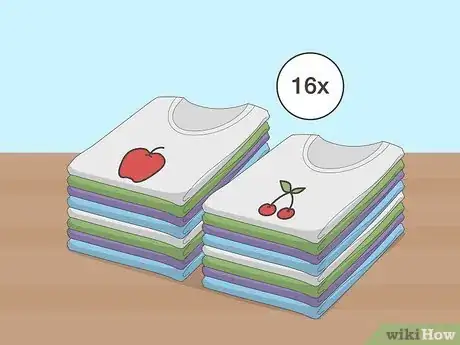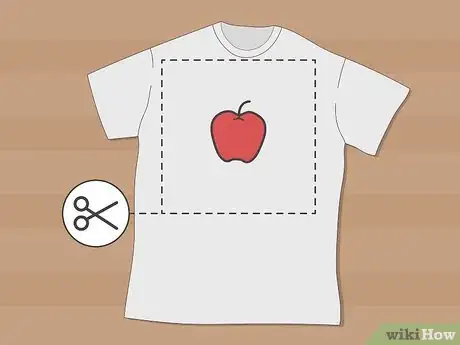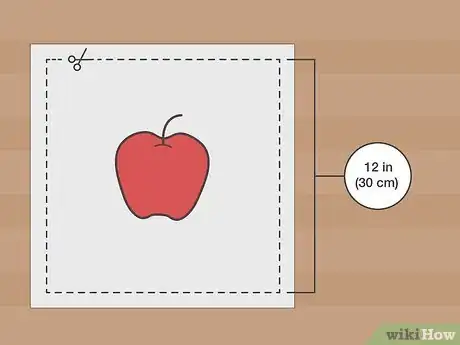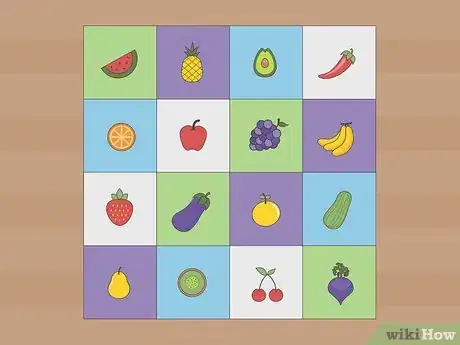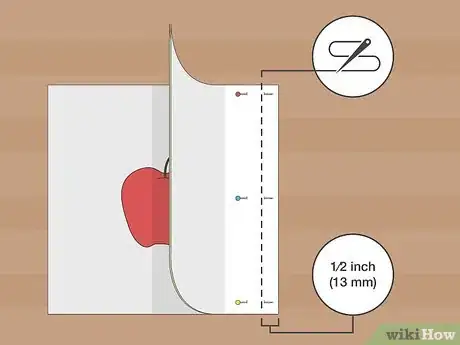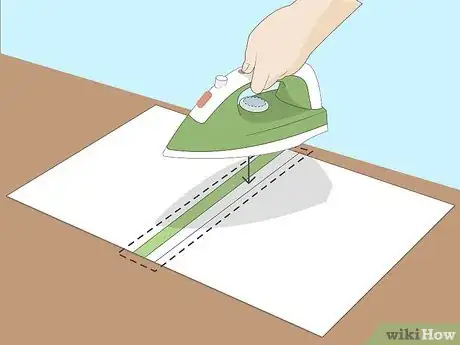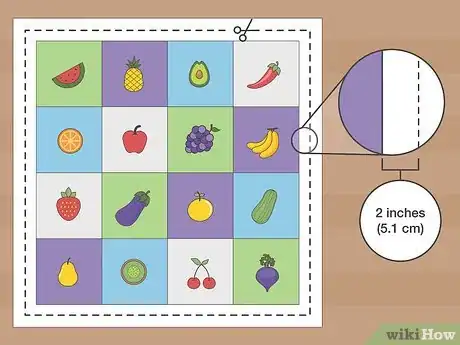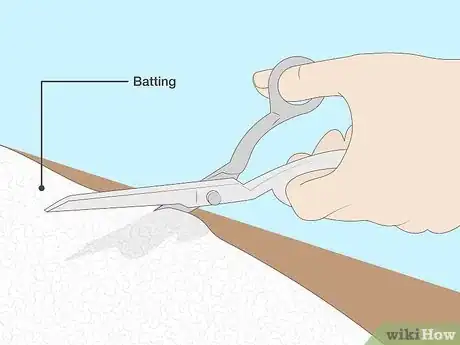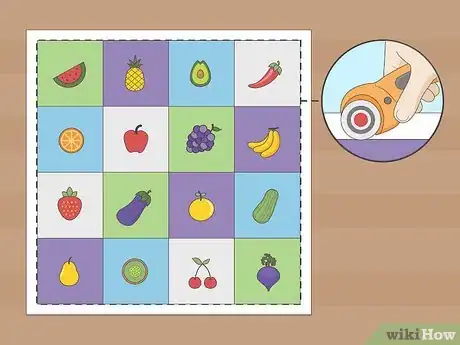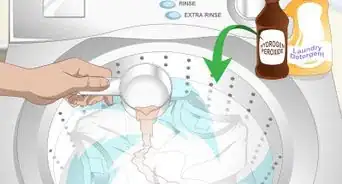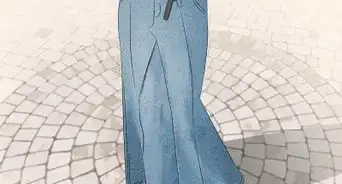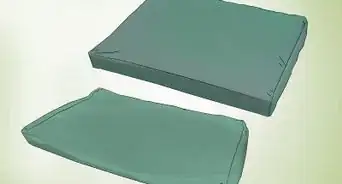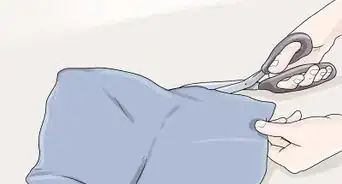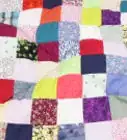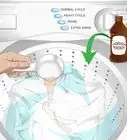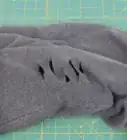This article was co-authored by Lois Wade and by wikiHow staff writer, Jessica Gibson. Lois Wade has 45 years of experience in crafts including sewing, crochet, needlepoint, cross-stitch, drawing, and paper crafts. She has been contributing to craft articles on wikiHow since 2007.
There are 12 references cited in this article, which can be found at the bottom of the page.
wikiHow marks an article as reader-approved once it receives enough positive feedback. This article received 83 testimonials and 95% of readers who voted found it helpful, earning it our reader-approved status.
This article has been viewed 1,837,018 times.
If you have old T-shirts that you can't bear to throw away, repurpose them into a new quilt! Cut a large square out of each shirt and arrange them into a pattern that you like. Fuse interfacing to the squares so they're easy to handle and sew them into rows. Then sew the rows together to make a top for your quilt. To assemble the quilt, layer a large piece of backing, batting, and the T-shirt top. Sew the layers together to make your custom T-shirt quilt.
Steps
Cutting the T-Shirts
-
1Gather 16 T-shirts. Look for T-shirts that have sentimental value that you want to use in the quilt. It's fine if the edges of the shirts are fraying, since you'll only be using the center of the shirts. If you'd like a larger quilt, gather more shirts and remember to scale up in an equivalent ratio.[1]
- For a monochromatic quilt, choose T-shirts in the same color. If you prefer, use any shirts with sentimental value to make a vibrantly colored quilt.
- 16 T-shirts are needed to make a quilt that's 4 blocks by 4 blocks [12 by 12 inches (30 cm × 30 cm)] in size.
-
2Cut out the center of each shirt into a rough square. Take sharp scissors and cut the main image you want to use from each T-shirt. The square should be at least 12 inches (30 cm) or larger. For example, if you want to include a list of team names from the back of a shirt, cut a large square from the back.[2]
- The squares don't need to be completely straight or smooth because you'll be cutting them again later.
Advertisement -
3Iron fusible interfacing to the back of each T-shirt square. To stabilize the T-shirt squares, lay your squares face-down on an ironing board. Lay a piece of fusible interfacing over the square and iron it with low heat. This should fuse the interfacing to the back of the T-shirt square. Repeat this for each T-shirt square.[3]
- The fusible interfacing will make your T-shirts easier to work with since they'll prevent the knit fabric from stretching or sagging a lot.
- Read and follow the manufacturer's instructions for specific directions about fusing the interfacing. You'll need to place the bumpy, fusible adhesive side so it faces the fabric.
-
4Trim each T-shirt to a 12 in (30 cm) square. Slide a cutting mat under the T-shirt square and place a ruler or clear template over the T-shirt. Center the image and then mark around the edges to make a 12 in (30 cm) square. Use scissors or a rotary cutter to trim the fabric so you get a tidy square.[4]
- If you want, make your squares larger or smaller. Keep in mind that you can adjust the overall size of the quilt too.
- Repeat this for each block so every T-shirt square is uniform in size.
Designing the Layout
-
1Decide the dimensions of the quilt. Since you have 16 T-shirt squares to work with, decide how many blocks you want in each row. For a square quilt, you'll have 4 rows with 4 blocks in each row. If you'd like a rectangular quilt, plan on 5 rows with 3 blocks in each.[5]
- If you're using more blocks, you can make larger or longer rows.
-
2Lay each T-shirt square where you'd like it to be in the quilt. Once you've chosen how many blocks you want in each row of your quilt, spread the squares out. Place the squares where you'll eventually want to sew them in place. This will allow you to see how the quilt should end up looking.[6]
- Play around with moving the squares to determine what looks best to you.
- For a chronological quilt, place squares that have years on them from the earliest date to latest.
-
3Pin the edges of the blocks together to hold them in place. To make it easier to sew the squares together, take the sewing pins and pin the edges of the squares together so the front sides of each square face each other. Keep in mind that these aren't supposed to secure the squares permanently. They'll just keep them organized while you're sewing the squares together.[7]
- Work two blocks at a time so you can focus on one shared edge at a time.
Sewing and Quilting the Squares
-
1Leave a 1⁄2 inch (13 mm) allowance and sew the blocks together. Hold the block edges in place and use a sewing machine to sew the fabric together to make a row. Once you've finished a row, set it aside and sew the blocks for another row.[8]
- If you have a walking foot for your sewing machine, attach it to make it easier to sew.
-
2Press the seams open and iron them flat. Lay a sewed row on your ironing board so the T-shirt squares are facing down. Pull the seams open between the squares you sewed. Then take a warm iron and run it over the seams to flatten them.[9]
- Ironing the seams flat will make it easier to quilt the material.
-
3Sew the rows of T-shirt squares together and iron the T-shirt top. To make them easier to sew, pin the edges of the rows together. Remember to leave a 1⁄2 inch (13 mm) seam allowance as you sew the rows together. Once you've sewn all the T-shirt squares together, iron them so they lie completely flat.[10]
- Keep the seams open as you sew across them. This will ensure that they stay flat.
-
4Cut the backing to be 2 inches (5.1 cm) larger on every side. Take your backing and measure it so it's as large as the T-shirt top that you just sewed. Add 2 inches (5.1 cm) to each edge and then use scissors to cut the large piece of backing.[11]
- For example, if you're making a quilt that's 4 blocks of 12 inches (30 cm) by 4, the blanket will be about 45 by 45 inches (110 cm × 110 cm), taking seam allowances into account. To add 2 inches (5.1 cm), you'll need a piece of backing that's 52 by 52 inches (130 cm × 130 cm).
-
5Cut a large piece of batting. Measure your quilt top and then use scissors to cut a piece of batting that's the same size as the quilt top. You'll use this to fill the quilt, which is why it's important that the size is the same.
- If you want a very thin quilt, leave out the batting entirely.
-
6Lay the batting and T-shirt top face up on the backing. Spread the backing on your work surface and place the batting on the backing. Then put the T-shirt top on the batting so the images are facing up.[12]
- The batting will make the quilt fluffier and will insulate it. For a thicker quilt, add an extra layer of batting.
-
7Pin the quilt layers and machine stitch the quilt together. Take sewing pins and insert them through the backing, batting, and T-shirt top. Put at least 1 sewing pin in each square to secure the layers as you handle the quilt. Then start in the center of the blanket and sew along the edges of every T-shirt block.[13]
- For the simplest way to quilt, sew it back and forth in straight lines.
Trimming and Binding the Quilt
-
1Use a rotary cutter to trim off the edges of the quilt. Lay your quilt flat on a work surface and slide a cutting mat under one edge of the quilt. Take your rotary cutter and cut away the excess batting and backing from the edge. Do this for every edge of the quilt.[14]
- You should only see a neatly trimmed T-shirt topping once you've trimmed off the excess from the edges.
-
2Cut and sew the binding fabric into a large square. Take the decorative binding fabric that you want to use to finish your quilt and cut it into strips that are twice as wide as you'd like and as long as the quilt. Sew the pieces together to create sharp corners that lie flat. Then fold the binding in half and iron it until it's smooth.[15]
- For a 48 by 48 inches (120 cm × 120 cm) quilt, consider cutting the binding into 2 1⁄4 inches (5.7 cm) strips.
-
3Sew the binding to the edges of the quilt. Pin the binding in place and hold the open edge of the binding along the edge of the quilt. Sew along the edges and leave a 1⁄4 inch (6.4 mm) seam allowance as you go. Then fold the binding over and sew the binding shut along the edges. Then remove any pins and enjoy your quilt.[16]
- Trim the end and fold it under the binding just before you finish sewing the last edge.
Community Q&A
Did you know you can get answers researched by wikiHow Staff?
Unlock staff-researched answers by supporting wikiHow
-
QuestionHow much does it cost to have a T-shirt quilt made?
 wikiHow Staff EditorThis answer was written by one of our trained team of researchers who validated it for accuracy and comprehensiveness.
wikiHow Staff EditorThis answer was written by one of our trained team of researchers who validated it for accuracy and comprehensiveness.
Staff Answer wikiHow Staff EditorStaff Answer
wikiHow Staff EditorStaff Answer -
QuestionWhat’s the best stabilizer for T-shirt quilts?
 wikiHow Staff EditorThis answer was written by one of our trained team of researchers who validated it for accuracy and comprehensiveness.
wikiHow Staff EditorThis answer was written by one of our trained team of researchers who validated it for accuracy and comprehensiveness.
Staff Answer wikiHow Staff EditorStaff Answer
wikiHow Staff EditorStaff Answer -
QuestionWhat can I use as a substitute for interfacing?
 wikiHow Staff EditorThis answer was written by one of our trained team of researchers who validated it for accuracy and comprehensiveness.
wikiHow Staff EditorThis answer was written by one of our trained team of researchers who validated it for accuracy and comprehensiveness.
Staff Answer wikiHow Staff EditorStaff Answer
wikiHow Staff EditorStaff Answer
Things You'll Need
- 16 T-shirts
- Fabric backing
- Fusible interfacing
- Scissors
- Iron
- Ironing board
- Ruler or clear template
- Rotary cutter
- Cutting mat
- Sewing pins
- Sewing machine and thread
- Batting
- Walking foot, optional
References
- ↑ http://www.straw.com/quilting/articles/teequilts_how.html
- ↑ https://youtu.be/Zk_c_Qbx-t4?t=34
- ↑ https://youtu.be/Zk_c_Qbx-t4?t=52
- ↑ http://www.straw.com/quilting/articles/teequilts_how.html
- ↑ https://www.motherearthnews.com/diy/t-shirt-quilt-zmaz06onzraw
- ↑ http://www.straw.com/quilting/articles/teequilts_how.html
- ↑ https://youtu.be/Zk_c_Qbx-t4?t=100
- ↑ https://youtu.be/Zk_c_Qbx-t4?t=104
- ↑ https://youtu.be/Zk_c_Qbx-t4?t=115
- ↑ http://www.straw.com/quilting/articles/teequilts_how.html
- ↑ https://youtu.be/Zk_c_Qbx-t4?t=143
- ↑ http://www.straw.com/quilting/articles/teequilts_how.html
- ↑ https://youtu.be/Zk_c_Qbx-t4?t=165
- ↑ https://youtu.be/Zk_c_Qbx-t4?t=191
- ↑ https://youtu.be/Zk_c_Qbx-t4?t=247
- ↑ https://youtu.be/Zk_c_Qbx-t4?t=291
- ↑ http://www.straw.com/quilting/articles/teequilts_how.html
About This Article
To make a quilt from tee shirts, gather shirts with a similar color scheme or sentimental value. Next, choose the shirts you want to use, launder them, and cut squares out of the front or back of each one, making sure each square is exactly the same size. Stabilize the tee shirt squares by ironing a non-woven fusible interfacing to the back sides and lay them out on the floor in the pattern you want for your quilt. Pin the edges of the squares together where they touch, and then sew them to create the quilt top! For tips on finishing the quilt with a border and backing, read on!
